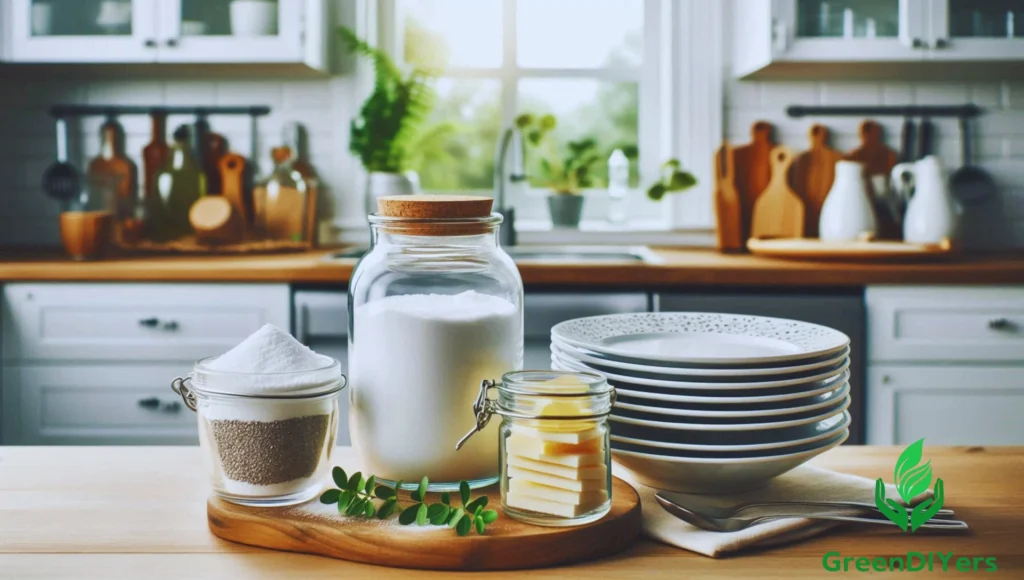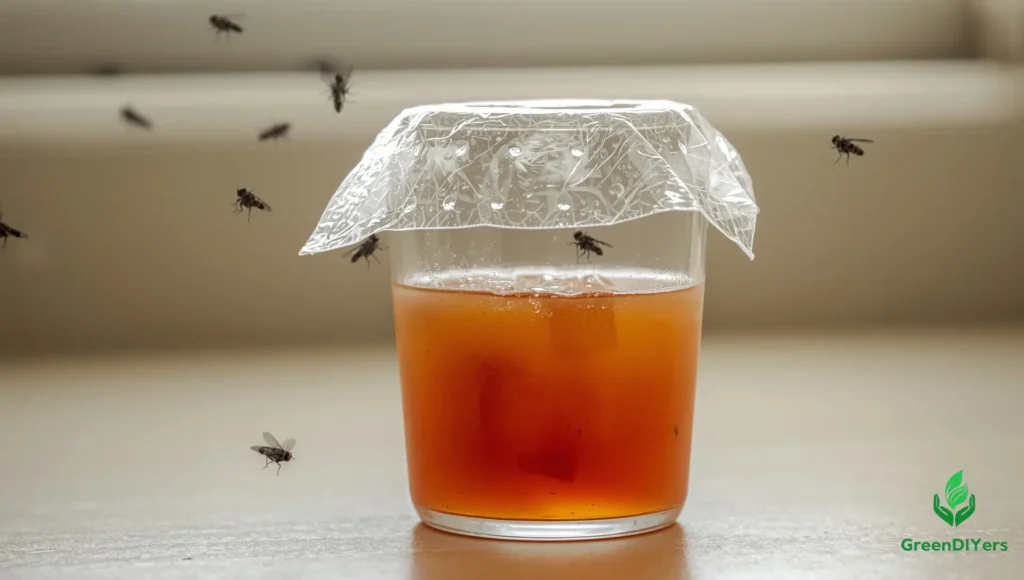Tired of spending a fortune on commercial dishwasher detergents that leave your glasses cloudy and your plates still greasy? Or maybe you’re concerned about the harsh chemicals lurking in those brightly colored pods that could be affecting your family’s health?
You’re not alone. Thousands of households are discovering that making their own DIY dishwasher detergent isn’t just possible—it’s actually more effective than many store-bought alternatives.
In this comprehensive guide, you’ll learn everything you need to know about creating homemade dishwasher detergent that delivers spotless results. We’ll cover the science behind each ingredient, provide foolproof recipes for powder, liquid, and pod formulations, and share expert troubleshooting tips to handle any challenge your dishwasher throws your way.
Why make your own dishwasher detergent? The benefits go far beyond cost savings (though you’ll save up to 80% compared to commercial brands). You’ll have complete control over ingredients, reduce your environmental footprint, and create a product that’s perfectly tailored to your water hardness and cleaning needs.
Table of Contents
Why Choose Homemade Dishwasher Detergent?
Cost Savings: The Numbers Don’t Lie
Let’s break down the economics. A typical commercial dishwasher detergent costs about $0.25 per load. Making your own DIY dishwasher detergent brings that cost down to just $0.05 per load—that’s an 80% savings!
For a family running their dishwasher daily, homemade detergent saves approximately $75 per year. Over five years, you’re looking at nearly $400 in savings—enough for a weekend getaway or a nice appliance upgrade.
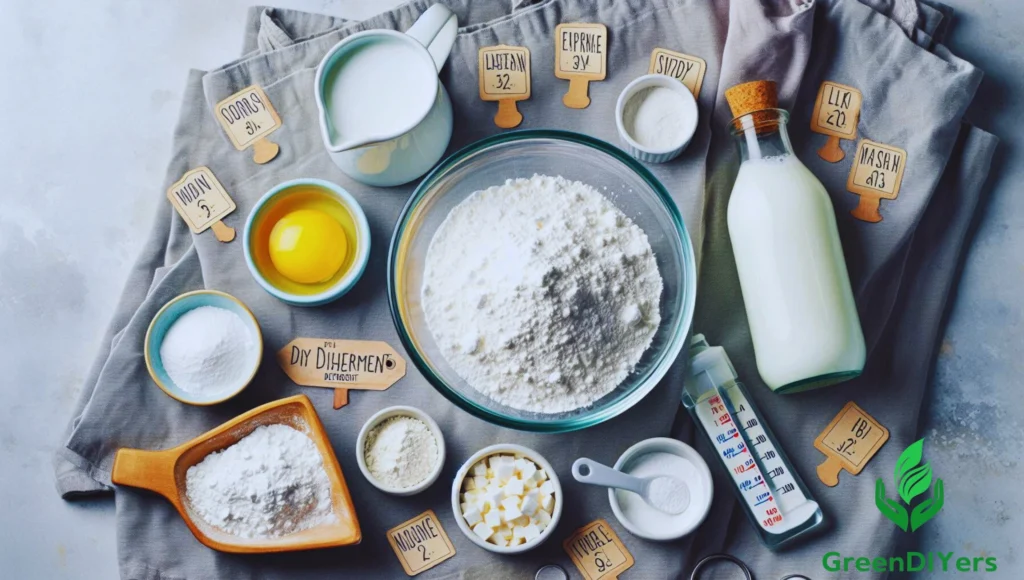
Complete Ingredient Control
When you make your own detergent, you know exactly what’s cleaning your dishes. No mysterious “fragrance” chemicals, no synthetic dyes, and no harsh surfactants that could trigger allergies or sensitivities.
You can customize the formula based on your family’s needs—add extra degreasing power for heavy cooking households or create a gentler version for delicate glassware.
Environmental Benefits That Matter
Commercial detergents come with significant environmental costs: plastic packaging that ends up in landfills, synthetic compounds that don’t break down naturally in wastewater, and transportation emissions from shipping heavy products across the country.
Homemade dishwasher detergent dramatically reduces your environmental footprint. Most ingredients come in bulk packaging or recyclable containers, and the natural formulations biodegrade completely.
Allergy and Sensitivity Friendly
Many people suffer reactions to commercial dishwasher detergents—from skin irritation to respiratory issues. When you control every ingredient, you can avoid problematic compounds and create a truly hypoallergenic cleaning solution.
Understanding the Science: Key Ingredients & How They Work
Washing Soda (Sodium Carbonate): The Powerhouse Cleaner
Washing soda is the heavy lifter in your DIY dishwasher detergent. This alkaline compound works by breaking down grease and protein-based stains while simultaneously softening water.
Where to find it: Look in the laundry aisle of most grocery stores, or order it online. Arm & Hammer makes a widely available version.
How it works: Washing soda raises the pH of your wash water to around 11, creating an environment where grease molecules break apart and lift away from surfaces. It also binds with calcium and magnesium ions in hard water, preventing them from interfering with the cleaning process.
Safety precautions: Always wear gloves when handling washing soda, as it can be irritating to skin and respiratory system.
Borax (Sodium Tetraborate): The Cleaning Booster
Borax has been safely used in household cleaning for over a century. Despite some online myths, it’s considerably safer than many commercial detergent ingredients.
How it works: Borax acts as a cleaning booster by converting some water molecules to hydrogen peroxide, providing gentle bleaching action. It also has natural antimicrobial properties and helps remove stubborn stains.
Safety note: While borax is safe for household use, store it away from children and pets, and avoid inhaling the powder.
Citric Acid: The Spot Fighter
This natural compound, found in citrus fruits, is your secret weapon against hard water spots and mineral buildup.
How it works: Citric acid’s mild acidity neutralizes alkaline mineral deposits on dishes and helps prevent the white film that hard water can leave behind. It also helps dissolve soap scum and acts as a natural rinse aid.
Pro tip: For very hard water, you can double the citric acid in your recipe for better results.
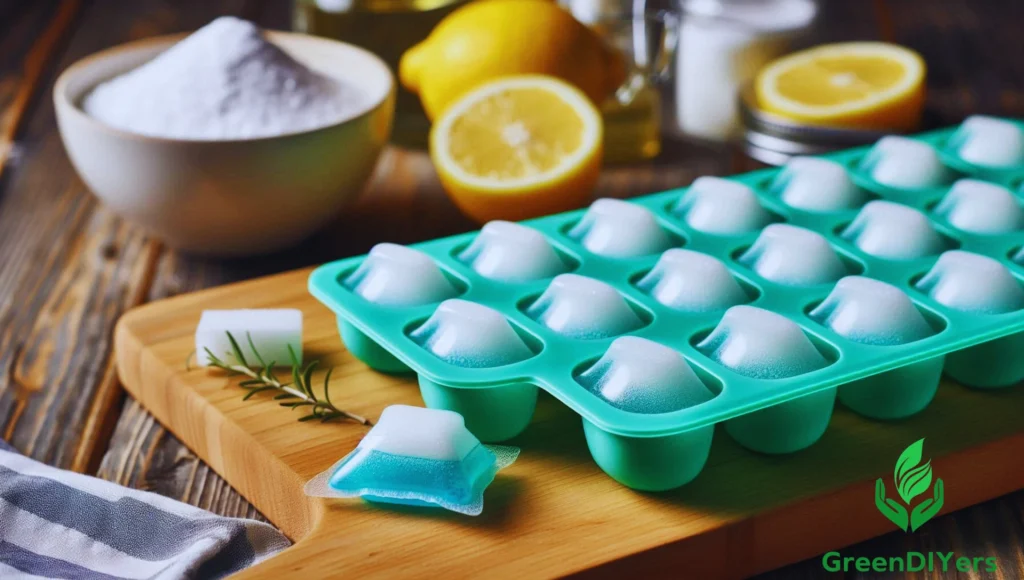
Baking Soda (Sodium Bicarbonate): The Gentle Scrubber
Baking soda provides mild abrasive action to help scrub away food particles while neutralizing odors.
Bonus: It also helps buffer the pH of your homemade detergent, preventing it from becoming too alkaline.
Kosher Salt: The Abrasion Helper
Coarse salt provides additional scrubbing action for stuck-on food and can help with minor water softening effects.
Essential Oils: Natural Fragrance (Optional)
A few drops of lemon or tea tree oil can add a pleasant scent and antimicrobial properties. However, use sparingly—too much oil can leave residue on dishes.
White Vinegar: The Essential Rinse Aid
Never underestimate the power of plain white vinegar as a rinse aid. Its acidity helps prevent water spots and ensures dishes dry completely clean.
Critical safety note: Never mix vinegar with chlorine bleach—this creates toxic chlorine gas.
The Ultimate Recipes for DIY Dishwasher Detergent
Recipe 1: Basic Powdered Detergent (Borax-Free)
Perfect for: Households avoiding borax, moderate soil levels
Ingredients:
- 1 cup washing soda
- 1 cup baking soda
- 1/2 cup citric acid
- 1/2 cup kosher salt
Instructions:
- Mix all ingredients thoroughly in a large bowl
- Store in an airtight container
- Use 1-2 tablespoons per load
Pro tip: For hard water, add an extra 1/4 cup citric acid to combat mineral buildup.
Recipe 2: Advanced Cleaning Powder (With Borax)
Perfect for: Heavy soil, very hard water, maximum cleaning power
Ingredients:
- 1 cup washing soda
- 1 cup borax
- 1/2 cup citric acid
- 1/2 cup kosher salt
- 1/4 cup baking soda
Instructions:
- Combine ingredients, mixing thoroughly
- Store in labeled, airtight container
- Use 1-2 tablespoons per load for normal soil, 3 tablespoons for heavy soil
Recipe 3: DIY Dishwasher Pods
Ingredients:
- 1 cup washing soda
- 1/2 cup citric acid
- 1/2 cup borax
- 1 tablespoon liquid castile soap
- 10-15 drops essential oil (optional)
Instructions:
- Mix dry ingredients thoroughly
- Add liquid soap and essential oils, mixing until mixture holds together when squeezed
- Press firmly into ice cube trays or silicone molds
- Let dry for 24-48 hours
- Store in airtight container
Recipe 4: Liquid Dishwasher Detergent
Ingredients:
- 1/2 cup liquid castile soap
- 1/2 cup white vinegar
- 1/4 cup washing soda dissolved in 1 cup hot water
Instructions:
- Dissolve washing soda completely in hot water
- Once cooled, mix with castile soap and vinegar
- Store in glass jar (may separate—shake before use)
- Use 2-3 tablespoons per load
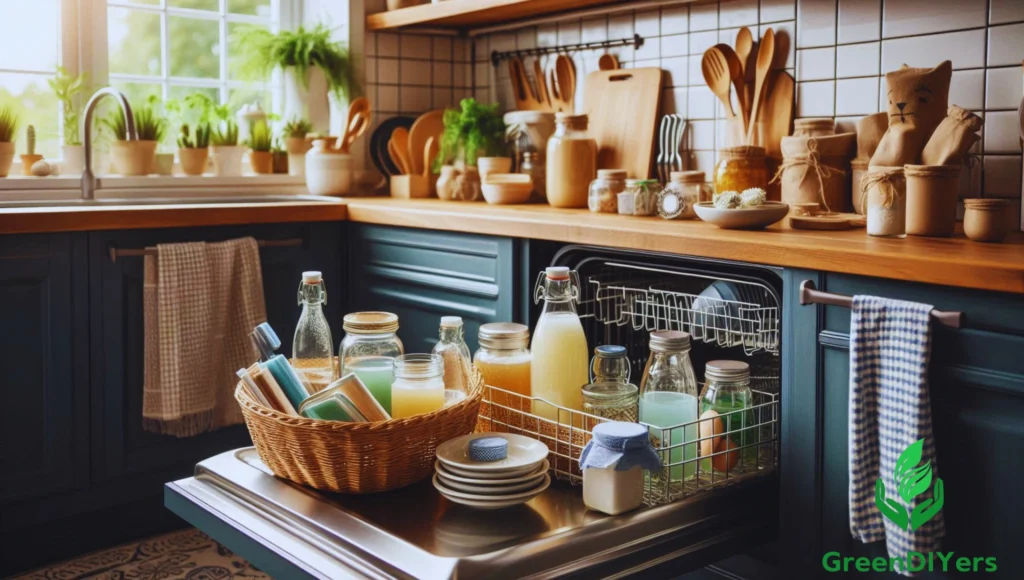
Crucial Considerations for Success
Understanding Your Water Hardness
Water hardness is the most important factor in DIY dishwasher detergent success. Hard water contains minerals that interfere with cleaning and can leave spots on dishes.
DIY Water Hardness Test: Fill a clear plastic bottle 1/3 with water, add 10 drops liquid dish soap, cap and shake vigorously. If you get lots of suds, you have soft water. Few suds with a milky appearance indicates hard water.
Recipe Adjustments:
- Soft water: Use 1 tablespoon detergent per load
- Medium hardness: Use 1.5 tablespoons per load
- Hard water: Use 2 tablespoons per load and increase citric acid by 50%
The Indispensable Role of Rinse Aid
Commercial rinse aid can cost $3-5 per bottle. White vinegar does the same job for pennies and works perfectly with homemade dishwasher detergent.
Fill your dishwasher’s rinse aid dispenser with undiluted white vinegar. It prevents water spots, helps dishes dry faster, and keeps your glasses crystal clear.
Pre-Rinsing Best Practices
Unlike commercial detergents that contain enzymes to break down food particles, DIY formulations work best when you scrape (don’t rinse) dishes before loading. This removes large food particles while preserving the natural oils that help your homemade detergent work effectively.
Troubleshooting Common Problems
| Problem | Possible Causes | Solutions |
|---|---|---|
| Cloudy Glassware | Too much detergent, very hard water, high heat settings | Reduce detergent amount, add more citric acid, lower water temperature to 120°F |
| White Residue on Dishes | Hard water, insufficient rinse aid, old detergent | Increase citric acid, ensure vinegar rinse aid dispenser is full, make fresh batch |
| Dishes Not Clean | Insufficient detergent, overloading, clogged spray arms | Increase detergent amount, proper loading technique, clean dishwasher monthly |
| Suds in Dishwasher | Too much liquid soap in recipe | Never use regular dish soap! Reduce liquid castile soap in future batches |
| Strong Chemical Odor | Ingredients not properly mixed, borax sensitivity | Remix batch thoroughly, try borax-free recipe |
Safety, Storage, and Best Practices
Ingredient Safety
Always handle washing soda and borax with gloves to prevent skin irritation. Store all ingredients in clearly labeled containers away from children and pets.
Proper Storage
Store your finished DIY dishwasher detergent in airtight glass or plastic containers. A cool, dry location like a pantry works perfectly. Properly stored homemade detergent lasts 6-12 months.
Making the Transition
Before switching to homemade detergent, run an empty cycle with 2 cups white vinegar to remove any commercial detergent residue from your dishwasher. This prevents interactions between old and new formulations.
Frequently Asked Questions
Q: Can I use regular dish soap in my dishwasher? A: Absolutely not! Regular dish soap creates too many suds and can damage your dishwasher or cause it to overflow.
Q: Is borax safe to use? A: Yes, when used properly. Borax is less toxic than many commercial detergent ingredients. However, store it safely away from children and pets.
Q: How much should I use per load? A: Start with 1-2 tablespoons and adjust based on your water hardness and soil level. More isn’t always better!
Q: Will this void my dishwasher warranty? A: No, using homemade detergent won’t void your warranty as long as you’re not damaging the machine through misuse.
Conclusion
Making your own DIY dishwasher detergent isn’t just a money-saving hack—it’s a game-changer for anyone who values clean dishes, environmental responsibility, and ingredient transparency.
With these proven recipes and troubleshooting guides, you have everything you need to create a dishwasher detergent that outperforms commercial alternatives while costing a fraction of the price.
Start with the basic recipe, adjust based on your water hardness, and don’t forget to use white vinegar as your rinse aid. Your dishes (and your wallet) will thank you!
Ready to make the switch? Try one of these recipes this weekend and experience the difference for yourself. Share your results and tag us on social media—we’d love to hear about your DIY dishwasher detergent success stories!

